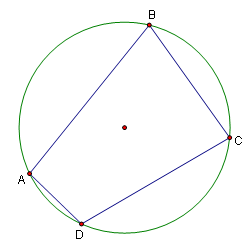Difference between revisions of "Cyclic quadrilateral"
m (→Properties) |
(→Properties) |
||
| (5 intermediate revisions by 4 users not shown) | |||
| Line 7: | Line 7: | ||
In a quadrilateral <math>ABCD</math>: | In a quadrilateral <math>ABCD</math>: | ||
| − | * <math>\angle A + \angle C = \angle B + \angle D = {180}^{o} </math> This property is both sufficient and necessary, and is often used to show that a quadrilateral is cyclic. | + | * <math>\angle A + \angle C = \angle B + \angle D = {180}^{o} </math> This property is both sufficient and necessary (Sufficient & necessary = if and only if), and is often used to show that a quadrilateral is cyclic. |
* <math>\angle ABD = \angle ACD</math> | * <math>\angle ABD = \angle ACD</math> | ||
* <math>\angle BCA = \angle BDA</math> | * <math>\angle BCA = \angle BDA</math> | ||
Latest revision as of 19:39, 9 March 2024
A cyclic quadrilateral is a quadrilateral that can be inscribed in a circle. While all triangles are cyclic, the same is not true of quadrilaterals. They have a number of interesting properties.

Properties
In a quadrilateral ![]() :
:
 This property is both sufficient and necessary (Sufficient & necessary = if and only if), and is often used to show that a quadrilateral is cyclic.
This property is both sufficient and necessary (Sufficient & necessary = if and only if), and is often used to show that a quadrilateral is cyclic.



- All four perpendicular bisectors are concurrent. The converse is also true. This intersection is the circumcenter of the quadrilateral.
- Any two opposite sites of the quadrilateral are antiparallel with respect to the other two opposite sites.
Applicable Theorems/Formulae
The following theorems and formulae apply to cyclic quadrilaterals:
This article is a stub. Help us out by expanding it.









